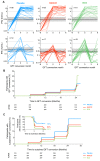Prevention of M. tuberculosis Infection with H4:IC31 Vaccine or BCG Revaccination
- PMID: 29996082
- PMCID: PMC5937161
- DOI: 10.1056/NEJMoa1714021
Prevention of M. tuberculosis Infection with H4:IC31 Vaccine or BCG Revaccination
Abstract
Background: Recent Mycobacterium tuberculosis infection confers a predisposition to the development of tuberculosis disease, the leading killer among global infectious diseases. H4:IC31, a candidate subunit vaccine, has shown protection against tuberculosis disease in preclinical models, and observational studies have indicated that primary bacille Calmette-Guérin (BCG) vaccination may offer partial protection against infection.
Methods: In this phase 2 trial, we randomly assigned 990 adolescents in a high-risk setting who had undergone neonatal BCG vaccination to receive the H4:IC31 vaccine, BCG revaccination, or placebo. All the participants had negative results on testing for M. tuberculosis infection on the QuantiFERON-TB Gold In-tube assay (QFT) and for the human immunodeficiency virus. The primary outcomes were safety and acquisition of M. tuberculosis infection, as defined by initial conversion on QFT that was performed every 6 months during a 2-year period. Secondary outcomes were immunogenicity and sustained QFT conversion to a positive test without reversion to negative status at 3 months and 6 months after conversion. Estimates of vaccine efficacy are based on hazard ratios from Cox regression models and compare each vaccine with placebo.
Results: Both the BCG and H4:IC31 vaccines were immunogenic. QFT conversion occurred in 44 of 308 participants (14.3%) in the H4:IC31 group and in 41 of 312 participants (13.1%) in the BCG group, as compared with 49 of 310 participants (15.8%) in the placebo group; the rate of sustained conversion was 8.1% in the H4:IC31 group and 6.7% in the BCG group, as compared with 11.6% in the placebo group. Neither the H4:IC31 vaccine nor the BCG vaccine prevented initial QFT conversion, with efficacy point estimates of 9.4% (P=0.63) and 20.1% (P=0.29), respectively. However, the BCG vaccine reduced the rate of sustained QFT conversion, with an efficacy of 45.4% (P=0.03); the efficacy of the H4:IC31 vaccine was 30.5% (P=0.16). There were no clinically significant between-group differences in the rates of serious adverse events, although mild-to-moderate injection-site reactions were more common with BCG revaccination.
Conclusions: In this trial, the rate of sustained QFT conversion, which may reflect sustained M. tuberculosis infection, was reduced by vaccination in a high-transmission setting. This finding may inform clinical development of new vaccine candidates. (Funded by Aeras and others; C-040-404 ClinicalTrials.gov number, NCT02075203 .).
Conflict of interest statement
TJS and MH report grants from Aeras. RR was a Sanofi Pasteur employee. SG and CADG are employees and share-holders at Sanofi Pasteur.
PA and IK report annual fees and milestone payments from Sanofi Pasteur and collaboration with Aeras and SATVI in other TB vaccine trials. PA has a patent WO2010/006607 "Vaccines comprising TB10.4" with royalties paid from Sanofi Pasteur to SSI.
TE, BL, DAH were employed by Aeras during the trial. KTR, RH and AMG report grants from Bill and Melinda Gates Foundation, grants from UK DFID, trial co-funding and in-kind support from Sanofi Pasteur, grants from DGIS (Dutch Government), during the conduct of the study; trial co-funding and in-kind support from GSK, outside the submitted work.
EN, HG, VR, FR, NB, SM, LM, ME, AT, HM, LGB, WAH, SGS, RDE have nothing to disclose.
Figures



Comment in
-
H4:IC31 Vaccine or BCG Revaccination for Tuberculosis.N Engl J Med. 2018 Nov 15;379(20):1969. doi: 10.1056/NEJMc1811046. N Engl J Med. 2018. PMID: 30428296 No abstract available.
References
Publication types
MeSH terms
Substances
Associated data
LinkOut - more resources
Full Text Sources
Other Literature Sources
Medical
